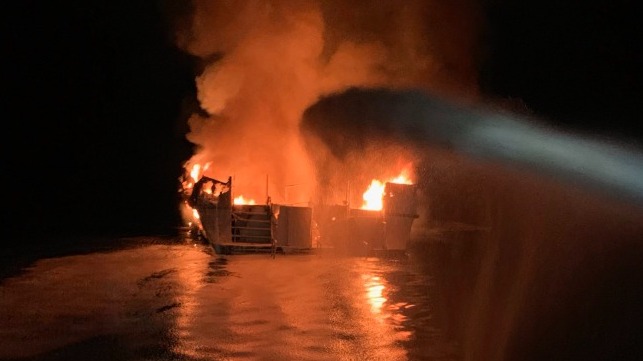US Coast Guard Sued for Wrongful Death in Conception Fire

At the second anniversary of the devastating fire aboard the dive boat Conception, the families of the 33 passengers and one crew member that died filed suit against the US Coast Guard for its alleged role in the tragedy. Filed in US District Court for the Central District of California the wrongful death and survival damages suit is in addition to civil and criminal actions pending against the captain and owner of the dive boat that burnt during the early morning hours of September 2, 2019, off the coast near Santa Cruz Island, California.
The new civil action seeks to position the Coast Guard as an enabler to the disaster due to failure to perform its roles to properly inspect and certify the vessel. In the year after the fire, the National Transportation Safety Board conducted one of several extensive investigations into the fire. While the NTSB did not identify the cause of ignition of the tragic fire it cited clear deficiencies in the vessel, its design, and equipment which are at the center of this lawsuit.
Papers filed with the court on September 1, cite the US Coast Guard’s role in developing and maintaining safety standards and conducting inspections. They highlight that the Coast Guard was required to conduct both annual inspections as well as five-year certifications.
“Even though her electrical wiring and systems, her fire detection and suppression systems, her passenger-accommodation escape hatch, her watch logs and training logs were in open and obvious violation of those procedures, protocols, and checklists,” the suit contends the Coast Guard repeatedly certified the vessel after its 2005 reconstruction and up until the fire. “The Marine Safety Detachment in Santa Barbara issued Conception her last Certificate of Inspection on or about November 19, 2014, and conducted an annual inspection in 2019, prior to Conception burning to the waterline in the catastrophe that is the subject of this action.”
The 48-page filing highlights that the Coast Guard developed, adopted, published, and updated the T-Boat Inspection Book under which the Conception operated, and among the elements of the code was the requirement to inspect and certificate the wiring and electrical systems to ensure compliance. The code also required checking that the vessel was equipped with the proper fire detection and suppression systems and suitable passenger escape hatches and passageways.
Supporting the contention that there were open and obvious violations aboard the Conception, the suit highlights that after the fire, USCG discovered numerous glaring deficiencies aboard the sister ship Vision in its wiring and electrical systems, fire detection and suppression systems, and passenger-accommodation escape hatch.
They also contend that the Coast Guard inspections overlooked undocumented and ill-designed modifications that were added to the vessel over the years and known faults in the electrical systems aboard the company’s dive boats. They say that it was known that the galley stove and the nitrox system could not be operated at the same time due to problems in the electrical system after the addition to the system and that additions created a clear danger in the practice of charging everything from cameras to cell phones. “Based on the information the Officer in Charge of Marine Inspections gathered in the inspections, examinations, and certifications described, the Coast Guard knew, or in the exercise of ordinary care should have known, that Truth Aquatics and the Fritzlers,” added undocumented and ill-designed electrical outlets throughout the vessel for battery charging.
In 2020, the U.S. Congress moved to tighten the safety regulations governing small boats such as the Conception. This week, the U.S. Coast Guard also highlighted that it has implemented “an initiative that enhances underway presence and improves safety aboard small passenger vessels operating off the California coast.” The safety compliance checks are being conducted underway on smaller, U.S. inspected passenger vessels to ensure continued regulatory compliance while vessels are conducting operations with paying passengers aboard.
“Our intent with these safety compliance checks is to bridge gaps that were identified following the fire onboard the passenger vessel Conception which resulted in the tragic deaths of 34 people,” said Rear Admiral Brian Penoyer, the Eleventh District commander. “We discovered that there are a number of operational requirements that are impossible to verify during a dockside annual inspection.”
The lawsuit, however, will seek to prove that by “ignoring, disregarding, and failing to abide by the procedures, protocols, and checklists set forth in the (T1 boat regulations) and the supplemental publications issued by the MSD,” that the US Coast Guard contributed to the death of the 34 people aboard the Conception.
